Before Pacquiao and Elorde, there was Luis Logan
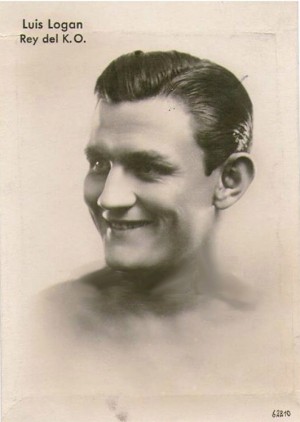
Luis Logan, in his twenties, initially hid his boxing career from his family.
(First posted in PositivelyFilipino.com)
WBO welterweight champion Manny Pacquiao on his 64th career title bout recently beat challenger Chris Algieri in Macau, China. He surged ahead of a little-known Filipino boxing pioneer who, because he boxed before the age of the Internet and “live” cable-subscription coverage, is mostly lost to today’s fans.
Before Flash Elorde, “Da Thrilla in Manila” and before Manny Pacquiao, there was one Luis Logan, a very non-typical “Filipino” who seems almost like a footnote in Philippine sports history.
Where present-day world champ Pacquiao has boxed 63 fights, won 36 bouts in four different weight classes on two continents, Luis Logan, a boxer in the 1920s and ’30s, held the Oriental Welter- and Orient Heavyweight titles in his day and waged a far-flung, professional boxing career in four (4, count ’em) continents: Asia, Europe, South America and Africa.
Until Pacquiao surpassed Logan’s record in 2013, Logan held one of longest professional boxing careers in Philippine boxing history, with 61 bouts fought and 49 victories.
Moreover, Logan was anything but Oriental, or your typical Malay-looking Filipino. In fact, he stood 6’3,” was auburn-haired and blue-eyed. But the most uncommon thing about Logan is that he did not come from an indigent background to find a way out of poverty. He came from an educated, fairly comfortable background but chose the profession because he really liked the sport. After all, he lived in the time of Hemingway.
“Luis Logan” came from ex-Valencia/Barcelona parentage, the Puig-Pellicers. Although he is sometimes classed with Spanish/Iberian boxers, “Logan” was actually born in the Philippines in 1907. His parents, Juan Puig Pellicer and Rosario Balmori immigrated to the Philippines just when the US took over the Islands from Spain. They moved to the Philippines to assume management of the San Lucas Hacienda in Bohol.
Logan was born Luis Puig Pellicer Balmori (going by the proper Spanish order of names) on February 15, 1907 in Calape, Bohol–thus was a Philippine national. He was the third of four brothers–Francisco, Juan Jr., Luis and Carlos. (For purposes of clarity, I will alternately use “Luis” or “Logan” depending on what time in his life we are talking about.)
(The Philippine Pellicers should’ve actually been surnamed “Puig,” but Juan Sr. got tired of people mispronouncing “Puig” (correct Catalan pronunciation: pu-ch, like putsch) in the newly Americanized Philippines that he dropped “Puig” and went with his maternal surname, the Frenchier-sounding “Pellicer” instead. Meantime, an uncle started the Puig fragrance business in Barcelona in 1914. Hence there are the Puigs of Spain and the Pellicers of the Philippines, but they are one and the same family. Today, the House of Puig in Europe is the leading fashion and fragrance house of Spain and carries the Hermes, Myrugia, Valentino, Carolina Herrera, Jeal-Paul Gaultier, Prada brands among others in its line-up. The House of Puig is also winding down its centennial celebration this year.)
It wasn’t until the 1920s that Juan Puig, Sr. moved his family to Manila. Around 1924, young Luis, because he was fluent in both English, Spanish (and Cebuano), got his first job as a stenographer in the bilingual Philippine Congress. However, one day he decided to concentrate on stenography only in Spanish–which seemed odd since proceedings in public life were veering towards English. Was he getting bored? Come New Year’s Eve 1924, Luis got into a physical altercation with a drunk American sailor who knocked out both his lights and his pride.
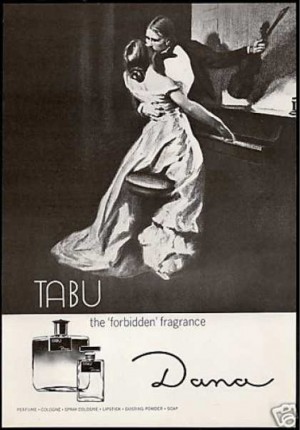
The classic ad for the classic perfume. Did boxing and perfumes mix? In Luis Pellicer’s world, they did. The Dana logo which I remember as a giant, colorful neon sign marking the Dana factory compound in Parañaque at night.
Luis recalled: “I committed the folly of leaving my face exposed, and didn’t have time to react accordingly because the American kept delivering blows. He didn’t stop until he left me cold on the ground.” That was all the motivation Luis needed to seek a change in careers.
The next day, Luis resolved to develop the necessary physical prowess that wouldn’t catch him off-guard in the future. “I picked up a sack filled with sand. I hung it in a room in my house and vented my frustrations on it as befit my daily rage. I was determined to acquire the skills needed to become a competent boxer.” Luis Pellicer Balmori was secretly on his way to a pugilistic career.
Because he knew his parents would disapprove of boxing, Luis resorted to using a “stage” name. He settled on “Luis Logan” which was, in a way, a combined tribute to his Spanish roots and the new “American” regime–so a touch of the Fighting Irish there with “Logan.” The Irish-American world heavyweight champion, Jack Dempsey, was one of the young Luis’ inspirations. It was a supreme irony that Logan came from a family of all boys no less but whose future line of business was selling ladies’ fragrances. And here was one of the sons pursuing the most “macho” of sports on the side, boxing, under still a different name.
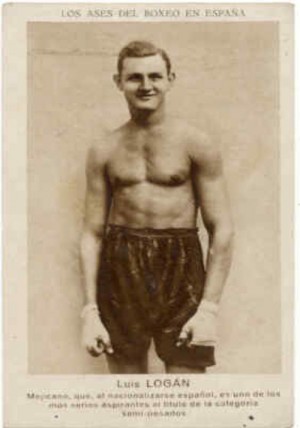
Advertisement in a Spanish Manila newspaper announcing a sort of (re)match between Logan and another member of the boxing Flores family, Irineo, for the Orient Welterweight Champion title , December 4, 1926. Note: Special seating arrangements will be provided for the ladies. General admission (bleacher seats) was ₱0.50. No time of fight is given. Logan, then 19, won this fight on points although Irineo Flores hit the floor five times. (Source: www.boxrec.com)
Logan persevered in his new, chosen career. From October 1925 to February 1928, he fought 16 opponents in Manila (one in Bataan), winning 13 of them, losing two and getting DQ (disqualified) in one. Logan earned the fighting nickname, El Rey del Knockout (King of the Knockout). So successful had the young Spanish-Filipino boxer become that he no longer had to hide it from his parents when he turned 21.
So in March 1928, no less than his own father accompanied Luis to Spain to launch a new phase in Luis’ boxing career, in Europe. At the same time, Juan Sr., sought to firm up Philippine sales rights on that trip, not only for products made by the Puig cousins, but also of rival cosmetics houses of Barcelona: Myrugia/Maja and Casa de Dana.
Later, Juan Pellicer got a head start with his business when Dana launched its signature Tabu fragrance in 1932. Tabu quickly became such a worldwide sensation that the Pellicers adopted “Dana Perfumes, Philippines” as their business name due to Tabu’s runaway success. Besides, “Dana” was an easier brand to market (rather than the Catalan “Puig”).
Meanwhile, Luis’ boxing career took off in Europe where there were more opponents on a par with his size and weight class. All in all, as a pro boxer, Logan fought 61 professional bouts. A brief chronological summary:
- October 1925 to February 1928, twenty-one (21) fights in Manila;
- 1928-1931, Spain, mostly in Barcelona but with one match each in Paris (March 22, 1930) and Algeria on July 26, 1930. The fight in Algeria vs. Bob Youssef was one of his two DQs (Disqualifications).
- 1st half of 1932 – five (5) fights in Argentina; then returned to Spain.
- June-December 1933, Logan returns to Manila for 3 more fights when he won his first Oriental Heavyweight title.
- November 1934 to January 1936 – back to Spain. The Republican government offers Logan Spanish citizenship in 1935 when the Tydings-McDuffie Act went into effect, one of whose provisions was to limit Filipino immigration to the US to only 50 immigrants per year. Before this act, Filipinos were classified as US nationals, but not US citizens. Despite the seemingly attractive offer from Madrid (i.e., he would have a bona fide European passport), Logan refused it. The Spanish Civil War then breaks out in 1936; Logan returns to Manila for five more fights before retiring in late 1940.
Where Pacquiao today is backed by a full support retinue, Logan did not enjoy such an advantage; but he managed to maintain a boxing career which spanned 15+ years. Where Manny, his team and family today hop continents in only 10 to 12 hours in the comfort of heated First/Business-Class seats, Logan traveled by steamship–taking at least 12 days from Manila to Barcelona on rough seas no less. Like many fighters of the time, Logan would just take on a manager and use local masseurs–no dedicated trainers; no personal traveling chef; no PR team; no whirlwind promo tours. For a detailed look at Logan’s boxing career, check it out on https://boxrec.com/list_bouts.php?human_id=40308&cat=boxer
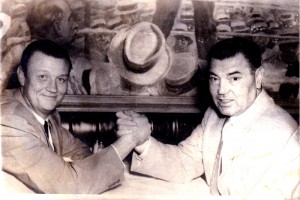
Logan, left, finally meeting his idol, ex-world heavyweight champion Jack Dempsey, right, in Manila, 1939. Dempsey came to Manila to referee the Ceferino Garcia-Glen Lee middleweight title fight on December 23, 1939, the first world title bout ever contested in the Philippines–36 years before “Da Thrilla in Manila”–and which is why it drew a name no less than Jack Dempsey, who flew halfway around the world on the new PanAm Clippers from New York City just to ref the fight. (Photo courtesy of Lolita Pellicer)
From that Commonwealth era, Luis Pellicer Logan probably embodied the unique peninsulares v. insulares rivalry in Manila’s Spanish mestizo community. By choosing a boxing career, Logan represented the likes of the working-class mestizos (including president Manuel L. Quezon) of the era. While the leading Manila clans, the Aranetas, Ayalas, Sorianos, Elizaldes, Ortigases, et al., continued to reign in the more refined sectors of business and high society on one end, and the less landed mestizos having a go in local show business on the other, Logan managed to straddle both worlds–being an heredero (heir) of Spanish/ European heritage while still pulling his own weight in the blue-collar trade of boxing.
In 1937, Logan took a hiatus from the boxing ring to put an actual ring on someone else’s finger. That was Dolores del Rio of the del Rio Steamship Lines’ family. Luis won Dolores’ heart in a whirlwind courtship of poetry and music. The southpaw boxer with the deadly left hook was also at home on the keyboard, having learned to play piano by ear, and was a romantic soul to boot. Luis and Dolores’ elegant 1937 wedding was a highlight of the Manila social season. The couple eventually had two children: Luis Jr. and Lolita.
By 1940, Logan hung up his boxing gloves and joined the family business. But World War II intervened and the Pellicers fared badly. Dana Perfumes was torched to the ground by the enemy and lay in ruins. Dona Rosario Pellicer, Luis’ older brothers Francisco and Juan Jr., and two nieces were senselessly massacred by the vengeful Japanese troops.
This personal tragedy egged Logan on to avenge their deaths by belatedly signing up with the remnants of the wartime Philippine (not US) Army. He joined the Cavalry unit and was promptly made captain of the 2nd Squadron. At 6’3,” Logan must’ve cut quite a figure in a cavalry uniform. By sheer dint of deja vu, the ex-boxer-turned-soldier took part in the battle of the Rizal Memorial Stadium complex, the scene of many of his earlier boxing triumphs.
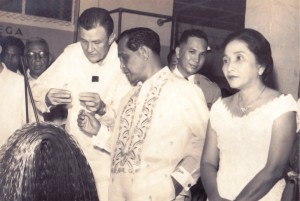
Logan the businessman guiding fellow Boholeño and Philippine President Carlos F., and first lady, Leonila Garcia, on a tour of the Dana Perfumes factory in Parañaque, 1958. Logan was also close to presidents Magsaysay and Macapagal. (Photo courtesy of Lolita Pellicer. Disclaimer: the author is not related to the other Garcias mentioned in this article.)
After the war, Logan was appointed special representative of the new Republic’s Department of Trade and Agriculture and made a “buyer” agent to the US, Central, South America and Europe–again, arenas of his earlier heyday.
Logan also revived the family’s fragrances business, adding the Mitsubishi Pencil company (oddly enough, any hard feelings towards the Japanese seemed to have been forgiven), Uniball writing instruments, French luxury goods purveyor LVMH and DFS (Duty-Free Shops) to the traditional Puig and Dana product brands. In his spare time, Logan didn’t forget his first passion, boxing, for he mentored and championed a handful of rising Filipino boxers on the side.
While there were no known detrimental effects to Logan’s overall health due to his long pugilistic career (unlike those in other contact sports today), Luis lost his last bout at home in Manila. The champ died ingloriously of a heart attack while watching TV in August 1965. El Rey del Knockout was only 59.
So, was Logan Spanish or Filipino? He very much considered himself Filipino. Like other insulares, he may have looked European, but his heart and soul were Filipino. After the personal devastation suffered in the war, Logan could have joined the reverse exodus of hundreds of Spanish-Filipino families who returned to Spain and started anew (more auspiciously with his cousins in Barcelona). But no, he stayed behind in the struggling, new republic, casting his lot with its uncertain future.
Sadly, Dana-Philippines, is no longer around today. But with this article, it is hoped that like a lingering whiff of a heady, exotic perfume, Luis Pellicer Balmori Logan will be remembered not only as a stellar boxer, but also as a successful family, business and community man who stayed modest and low-key despite having built an exemplary record any fighter would’ve been proud of. Luis Logan belongs to that pantheon of great Filipino boxers–alongside Flash Elorde, Ceferino Garcia, Pancho Villa, the Villanuevas and Manny Pacquiao–pre-Internet age or otherwise.
For more stories on the Filipino diaspora go to PositivelyFilipino.com
Acknowledgements:
- Sincere thanks to the Pellicer ladies: Luis’ daughter, Lolita, for her recollections and photographs; her daughter Lissa; and Luis’ niece Marilou, for facilitating the research and execution of this article.
- “Terror in Manila” (original title in Spanish, El Terror Amarilla) by Antonio Perez de Olaguer. Originally published in Spain, 1947. Translation, (c) 2005, MANILA MEMORARE 1945 Foundation.
- https://boxeo1930s.blogspot.com/2011/11/luis-logan-el-rey-del-ko.html
- www.BoxRec.com